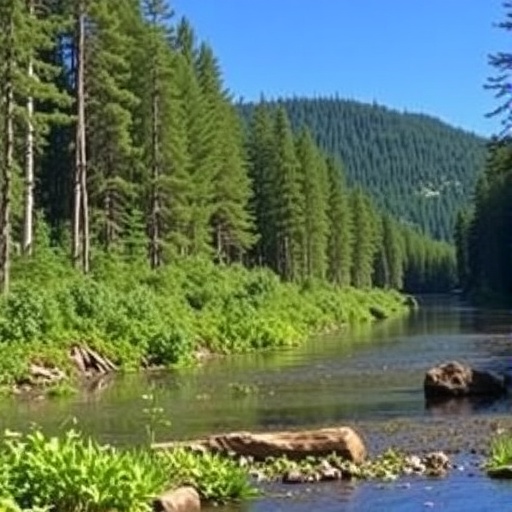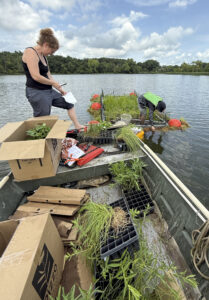Forests and Water: New Research Redefines Forest Restoration Insights – BIOENGINEER.ORG

Report on the Hydrological Benefits of Forest Landscape Restoration and its Contribution to Sustainable Development Goals
Introduction: A Paradigm Shift in Forest Hydrology and Sustainable Development
A recent synthesis of research challenges the long-standing view of forests as net consumers of water resources. New evidence indicates that large-scale Forest Landscape Restoration (FLR) can significantly enhance water availability, particularly dry-season river baseflow, which is critical for achieving multiple Sustainable Development Goals (SDGs). This report analyzes the hydrological mechanisms of FLR and frames its implications within the global agenda for sustainable development, focusing on water security, climate action, and ecosystem health.
Key Findings and Hydrological Mechanisms
The research highlights a critical shift in focus from total annual water yield to the stabilization of dry-season baseflow. This is achieved through several key mechanisms:
- Enhanced Soil Water Storage: Restored forests improve soil structure, creating a “sponge effect.” Tree roots and organic matter increase soil porosity and permeability, which promotes greater infiltration of precipitation and recharges groundwater reserves.
- Increased Dry-Season Flow: By replenishing groundwater, restored forests can sustain river flows during dry periods. This hydrological benefit can offset or exceed water loss from evapotranspiration, leading to a net increase in water availability when it is most scarce.
- Atmospheric Moisture Recycling: Forests contribute to regional climate stability by releasing moisture into the atmosphere, which can influence downwind precipitation patterns, supporting broader agricultural landscapes.
Implications for Sustainable Development Goals (SDGs)
Strategically implemented FLR serves as a powerful nature-based solution that directly contributes to the achievement of several interconnected SDGs.
-
SDG 6: Clean Water and Sanitation
- Target 6.4 (Water-use efficiency): FLR enhances the natural regulation and storage of water, increasing water availability during dry seasons and improving water security for communities and agriculture.
- Target 6.6 (Protect and restore water-related ecosystems): The core finding of the research directly supports the restoration of forests as critical water-related ecosystems essential for regulating the hydrological cycle.
-
SDG 15: Life on Land
- Target 15.1 (Conserve and restore terrestrial ecosystems): The report underscores the hydrological co-benefits of restoring forest ecosystems, reinforcing the importance of reforestation for both biodiversity and water services.
- Target 15.3 (Combat desertification and land degradation): FLR is presented as a primary tool for reversing land degradation, specifically by rebuilding the soil’s capacity to retain water and support productive ecosystems.
-
SDG 13: Climate Action
- Target 13.1 (Strengthen resilience and adaptive capacity): By stabilizing water supplies and mitigating the impacts of drought, restored forests build resilience in ecosystems and human communities against climate volatility.
-
SDG 2: Zero Hunger
- Target 2.4 (Sustainable food production): Reliable dry-season water flow is vital for agricultural productivity. FLR supports resilient food systems by ensuring water availability for irrigation and crop sustenance.
Strategic Implementation for Maximizing SDG Impact
The success of FLR as a tool for sustainable development is contingent on careful planning and context-specific application. Key strategic considerations include:
- Site-Specific Planning: Restoration efforts must be tailored to local climate, soil depth, and land degradation status. The greatest potential for water-related benefits is found in seasonal climates with degraded landscapes and deep soils.
- Appropriate Species Selection: Prioritizing native species, age-diverse forests, and integrated agroforestry models is crucial. These approaches optimize water infiltration while managing transpiration rates, avoiding the negative impacts associated with monocultures of fast-growing exotic species.
- Policy Integration: Environmental policies must be updated to reflect the role of forests as critical water infrastructure. This reframing can galvanize investment in FLR as a cost-effective, nature-based solution for water management.
- Continued Research: Further longitudinal studies are required to understand the long-term hydrological trade-offs and inform adaptive management strategies that are resilient to future environmental changes.
Conclusion: Forests as Hydrological Assets for a Sustainable Future
The research definitively repositions forest landscape restoration from a perceived water liability to a vital asset for global water security and sustainability. By functioning as hydrological engineers, restored forests can recharge groundwater, stabilize river flows, and build climate resilience. This function is fundamental to achieving integrated progress across the Sustainable Development Goals, particularly those related to water, climate, and terrestrial ecosystems. Acknowledging and acting upon this paradigm shift is essential for leveraging forests to build a more resilient and water-secure world.
Analysis of Sustainable Development Goals in the Article
1. Which SDGs are addressed or connected to the issues highlighted in the article?
The article on forest landscape restoration and its hydrological impacts directly addresses and connects to several Sustainable Development Goals (SDGs). The analysis identifies the following primary and secondary SDGs:
- SDG 6: Clean Water and Sanitation: This is the most central SDG discussed. The article’s main thesis is that forest restoration can enhance water availability, improve groundwater recharge, and stabilize dry-season river flows, which are all critical components of water security and management.
- SDG 15: Life on Land: The article is fundamentally about restoring terrestrial ecosystems. It focuses on “large-scale forest landscape restoration (FLR),” rehabilitating “degraded lands,” halting deforestation, and promoting the use of native species, which are core objectives of this goal.
- SDG 13: Climate Action: The research positions forest restoration as a key strategy for “climate resilience” and “climate adaptation.” By stabilizing water resources, especially during dry seasons, restored forests help ecosystems and communities adapt to “climate volatility.”
- SDG 2: Zero Hunger: The article connects water availability to food production by stating that stable river baseflow is “vital for… agricultural productivity” and that atmospheric moisture recycling from forests can bolster “agricultural productivity far beyond the forest margins.”
2. What specific targets under those SDGs can be identified based on the article’s content?
Based on the article’s discussion of forest restoration, water management, and climate resilience, several specific SDG targets can be identified:
SDG 6: Clean Water and Sanitation
- Target 6.5: Implement integrated water resources management. The article advocates for a “paradigm shift” in how forests are viewed in water management, promoting them as “strategic tools for water management” and a “nature-based solution” for global water security challenges.
- Target 6.6: Protect and restore water-related ecosystems. The entire article is a testament to this target, providing scientific evidence for how restoring forest ecosystems directly replenishes groundwater and revitalizes river flows, thus restoring the hydrological functions of the landscape.
SDG 15: Life on Land
- Target 15.1: Ensure the conservation, restoration and sustainable use of terrestrial and inland freshwater ecosystems. The research focuses on the hydrological services provided by restored forest ecosystems, directly supporting this target.
- Target 15.2: Promote the implementation of sustainable management of all types of forests, halt deforestation, restore degraded forests and substantially increase… reforestation globally. The article provides a strong scientific and practical argument for why “large-scale reforestation projects” and “forest landscape restoration” should be pursued.
- Target 15.3: Combat desertification, restore degraded land and soil. The research specifically focuses on the potential for restoration on “landscapes suffering past deforestation or degradation” and “degraded lands in the tropics,” directly aligning with this target.
SDG 13: Climate Action
- Target 13.1: Strengthen resilience and adaptive capacity to climate-related hazards. The article highlights that stabilizing dry-season river flows through forest restoration is a key mechanism for building “climate resilience” and adapting to “climate volatility,” particularly in regions facing increased water stress.
SDG 2: Zero Hunger
- Target 2.4: Ensure sustainable food production systems and implement resilient agricultural practices. The article supports this target by explaining how restored forests can ensure a more reliable water supply (“dry-season river baseflow”) which is “vital for maintaining… agricultural productivity.”
3. Are there any indicators mentioned or implied in the article that can be used to measure progress towards the identified targets?
The article, being a scientific synthesis, mentions and implies several specific, measurable indicators that can be used to track progress towards the identified targets.
Indicators for SDG 6 (Clean Water and Sanitation)
- Dry-season river baseflow: The article repeatedly emphasizes this as a key outcome. Measuring the volume and stability of river flow during dry periods would be a direct indicator of the success of restoration in enhancing water availability (Target 6.6).
- Groundwater storage/recharge: The research explains that restored forests promote precipitation infiltration, “leading to replenished groundwater storage.” Monitoring groundwater levels in and around restoration areas would serve as a direct indicator of ecosystem health (Target 6.6).
Indicators for SDG 15 (Life on Land)
- Area of restored forest on degraded land: The core activity described is “large-scale forest landscape restoration.” The total acreage of land successfully restored would be a primary indicator for Targets 15.2 and 15.3.
- Soil health metrics: The article implies indicators of soil recovery, such as “soil porosity and permeability” and the level of “accumulated organic matter.” These can be measured to track the restoration of land health (Target 15.3).
- Proportion of native vs. exotic species: The article cautions against “fast-growing exotic species” and advocates for “native species assemblages.” The composition of species used in restoration projects is a qualitative indicator of the ecological sustainability of the effort (Target 15.2).
Indicators for SDG 13 (Climate Action) and SDG 2 (Zero Hunger)
- Stability of water supply for agriculture: While not a direct climate indicator, the “invigorated flow during dry spells” serves as a proxy indicator for increased resilience to climate-induced droughts (Target 13.1).
- Agricultural productivity/yields: The article suggests that restoration bolsters “agricultural productivity.” Measuring crop yields in adjacent and downwind regions can serve as an indicator of the broader benefits of restoration for food systems (Target 2.4).
4. Summary Table of SDGs, Targets, and Indicators
| SDGs | Targets | Indicators |
|---|---|---|
| SDG 6: Clean Water and Sanitation |
|
|
| SDG 15: Life on Land |
|
|
| SDG 13: Climate Action |
|
|
| SDG 2: Zero Hunger |
|
|
Source: bioengineer.org
What is Your Reaction?
 Like
0
Like
0
 Dislike
0
Dislike
0
 Love
0
Love
0
 Funny
0
Funny
0
 Angry
0
Angry
0
 Sad
0
Sad
0
 Wow
0
Wow
0



















































.jpg.webp?itok=0ZsAnae9#)


















.jpg?#)






